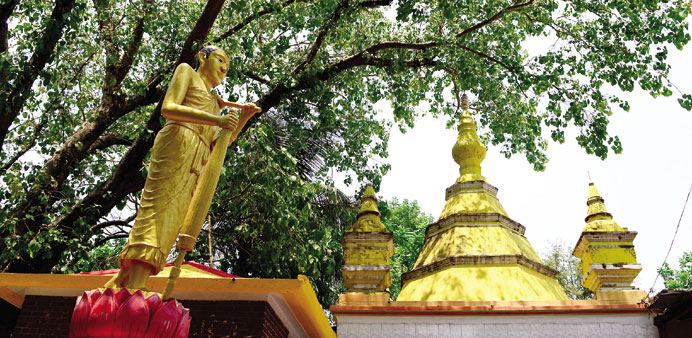SENTINEL: The entrance to the Rang-U Rangkut Banasram pagoda, the oldest Buddhist monastery in Bangladesh. Photos by Anand Holla
The fascinating history behind the oldest Buddha monument in Bangladesh only adds to its aura.
By Anand Holla
To reach the oldest Buddhist monastery in Bangladesh, you need to climb around 50 stairs. Once you step inside the Rang-U Rangkut Banasram pagoda, the sea of calm that embraces you will have you believe that your feet lie on a ground much higher than the one that the stairs took you to.
That is perhaps because just one look at the 6-ft tall greenstone sculpture of Gautam Buddha at Ramu — a sub-district that is about 15km from Cox’s Bazar — evokes a peaceful feeling that makes you want to turn inward.
Although tourists usually flock to Cox’s Bazar in southeast of Bangladesh to soak in the world’s longest sea beach that stretches across 121km, taking a trip instead to Ramu is an unparalleled soul-cleansing experience.
Of all, the country’s oldest stupa (a dome-shaped structure serving as a Buddhist shrine) at Rangkut has an illustrious history that underlines its importance and adds to its aura.
The story goes that Dhanyawadi was a prosperous capital of the ancient world of Arakan and Chandrasurya was its king. On his invitation, Buddha visited this place on foot through Chittagong. To his chief attendant Ananda, Buddha revealed that in the near future on the eastern mountain range of western ocean (The Bay of Bengal), his chest bone will be preserved in a stupa.
Buddha then said that the area will be called Rang-U, which means the sacred chest bone, and as it would be preserved on the hill top, it’s called Rangkut (a mountain with sacred chest bone). This prediction is said to have been discovered upon on decoding the stone script of that era.
During his reign (273-232 BC), Emperor Ashoka the Great spread his vast kingdom to Ramyavati Nagar, the ancient name of Rangkut, which was in the southeastern border of his empire. In fact, Ashoka even excavated and collected the preserved bone relics of the Buddha, which was earlier restored by King Ajatshatru of the Magada after the demise of Buddha.
The excavated bone relics were preserved in 84,000 stupas or cetiyas. Each stupa was eventually turned into a Buddhist shrine by devotees. The Rangkut too is one of those stupas that Ashoka built, thereby realising Buddha’s prediction. If you observe closely, the Rangkut also has some Ashoka pillars.
In the 6th Century AD, during the reign of Raja Cendi, a large Buddha statue was established here. The chest bone of Buddha was embedded in it, and it now sits in fine splendour. Veteran monk Shashamo Bangsa Bhikkhu says, “We paint it and renovate it every now and then.”
Even the setting for this
centuries-old monument in a village dotted with palm trees and lush paddy fields is rather spectacular. Once you pass the majestic golden gate on your way to the monastery, you will find statues of Buddha that inspire awe. The rich treasure chest of Buddhist temples, statues in bronze and gold, unravel across the place.
And on the foot of a hillock that houses the Rangkut, is a sprawling banyan tree which is more than 400 years old.
“People from all walks of life come here to seek peace of mind. We welcome everybody,” Bhikkhu says. The monks residing here wake up at 3am and meditate, pray and chant till 5pm.
Two years ago, around 10 Buddhist temples and around 40 Buddhist homes in Ramu came under attack as a reaction to a controversial photo on a social networking site. The Rangkut though survived the mob’s ire as the locals succeeded in securing it.
“We felt scared as things seemed unstable. But slowly, the situation is turning normal again,” Bhikhhu says, with a hint of optimism. “We believe in prayer, and in hope. He will show us the way,” he says, looking up. Standing inside the Rangkut, it somehow seems easy to believe him.
BELOW:
SERENE: The 6-ft tall greenstone sculpture of Gautam Buddha at Ramu.

